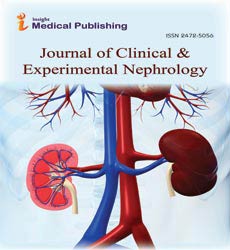Dialysis: A Lifesaving Therapy for Kidney Failure
Rui Xiaobo*
Department of Paediatric Nephrology, The Chinese University of Hong Kong, Hong Kong, China
Published Date: 2024-10-25DOI10.36648/2472-5056.9.5.278
Rui Xiaobo*
Department of Paediatric Nephrology, The Chinese University of Hong Kong, Hong Kong, China
- *Corresponding Author:
- Rui Xiaobo
Department of Paediatric Nephrology, The Chinese University of Hong Kong,
Hong Kong,
China,
E-mail: xiaming@hon.cn
Received date: September 24, 2024, Manuscript No. IPJCEN-24-19843; Editor assigned date: September 27, 2024, PreQC No. IPJCEN-24-19843 (PQ); Reviewed date: October 11, 2024, QC No. IPJCEN-24-19843; Revised date: October 18, 2024, Manuscript No. IPJCEN-24-19843 (R); Published date: October 25, 2024, DOI: 10.36648/2472-5056.9.5.278
Citation: Xiaobo R (2024) Dialysis: A Lifesaving Therapy for Kidney Failure. J Clin Exp Nephrol Vol.9 No.5: 278.
Description
Dialysis is a medical procedure that serves as an artificial replacement for lost kidney function in people with renal failure. When the kidneys fail, they are unable to filter waste products and excess fluids from the blood, which leads to the accumulation of toxins in the body. Dialysis is vital in maintaining a balance of fluids, electrolytes and waste products, allowing patients to continue living even with severely impaired kidney function. The necessity of dialysis arises when kidney function falls below 15%, typically due to Chronic Kidney Disease (CKD) or Acute Kidney Injury (AKI). This therapy is not a cure for kidney failure, but it prolongs life and improves the quality of life for those with End-Stage Renal Disease (ESRD). There are two main types of dialysis: Hemodialysis and peritoneal dialysis. Both have unique mechanisms, but the ultimate goal is the same: To filter and cleanse the blood. Hemodialysis is the most common form of dialysis. Blood is drawn from the patient’s body, passed through the dialyzer and then returned to the body after filtration. This process removes excess waste, salt and fluids. The dialyzer consists of tiny fibers that allow waste products to pass through while keeping necessary substances like proteins and red blood cells inside the body. Hemodialysis usually requires treatments three times per week, with each session lasting three to 5 h. During the procedure, blood is taken from the body through an access point, usually in the arm, known as a fistula, graft, or catheter. Maintaining this access point is critical for the success of treatment. Although hemodialysis effectively removes toxins and excess fluid, it can be physically demanding. Side effects like fatigue, low blood pressure, muscle cramps and infections at the access site are common.
Peritoneal dialysis
Peritoneal dialysis is another dialysis method that uses the lining of the abdomen, or peritoneum, as the filter. The peritoneum’s blood vessels act as a natural filter and after a few hours, the fluid is drained, carrying with it waste products and extra fluid. There are two types of peritoneal dialysis: Continuous Ambulatory Peritoneal Dialysis (CAPD): In this form, the patient manually exchanges the dialysate several times a day, typically four to five times. No machine is required, allowing patients more freedom. Automated Peritoneal Dialysis (APD): This method uses a machine called a cycler to perform exchanges automatically, often while the patient sleeps. Peritoneal dialysis offers more flexibility than hemodialysis and can be done at home, making it a favorable option for patients who prefer a less intrusive lifestyle. However, it requires a high degree of patient involvement and discipline to maintain cleanliness and prevent infections, such as peritonitis. Dialysis is indicated when the kidneys can no longer perform their essential functions adequately. Common indications for dialysis include: Chronic Kidney Disease (CKD) progressing to End-Stage Renal Disease (ESRD) Severe Acute Kidney Injury (AKI) with rapidly declining kidney function Life-threatening imbalances in electrolytes excessive fluid overload unresponsive to diuretics uremic symptoms, such as nausea, confusion and fatigue patients with these conditions require dialysis to avoid dangerous accumulations of toxins and fluids.
Hemodialysis
While dialysis is a physically and emotionally taxing process, significant advances in treatment and patient care have improved outcomes. Patients are encouraged to maintain an active lifestyle, adhere to dietary recommendations and follow strict medication regimens to prevent complications. In recent years, the importance of addressing malnutrition and muscle wasting in dialysis patients has become more recognized. Intradialytic Oral Nutrition (IDON) has emerged as an intervention to provide patients with nutritional supplements during dialysis sessions. This method helps combat proteinenergy wasting and improve clinical outcomes by providing necessary nutrients while limiting gastrointestinal discomfort. Another aspect that improves quality of life is home dialysis. Both peritoneal dialysis and home hemodialysis allow patients more flexibility and independence, reducing the burden of frequent hospital visits. As medical technology advances, new methods are being developed to improve the effectiveness and comfort of dialysis. The development of wearable dialysis devices and bioartificial kidneys offers hope for patients by potentially eliminating the need for large machines and hospitalbased treatments. These innovations aim to mimic natural kidney function more closely and provide better quality of life for patients with kidney failure.
Open Access Journals
- Aquaculture & Veterinary Science
- Chemistry & Chemical Sciences
- Clinical Sciences
- Engineering
- General Science
- Genetics & Molecular Biology
- Health Care & Nursing
- Immunology & Microbiology
- Materials Science
- Mathematics & Physics
- Medical Sciences
- Neurology & Psychiatry
- Oncology & Cancer Science
- Pharmaceutical Sciences
